



Click on the links above for accounts and photos of these trips.
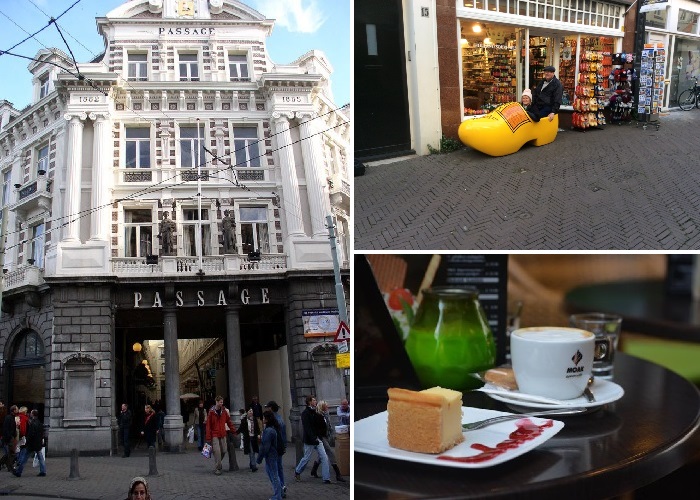 The following day was another action packed tour of Holland with our first stop at The Hague; we walked through the shopping center where Nick and Jane decided that this shoe was just too big for them both (it's a bit like kids sitting in a toy car outside the shops - LOL). We went to the Novotel sponsored shopping mall known as 'De Passage' where we stopped for morning coffee at DeLuca's; the shortcake was delicious with each plate decorated with Deluca in strawberry syrup - mmmm!
The following day was another action packed tour of Holland with our first stop at The Hague; we walked through the shopping center where Nick and Jane decided that this shoe was just too big for them both (it's a bit like kids sitting in a toy car outside the shops - LOL). We went to the Novotel sponsored shopping mall known as 'De Passage' where we stopped for morning coffee at DeLuca's; the shortcake was delicious with each plate decorated with Deluca in strawberry syrup - mmmm!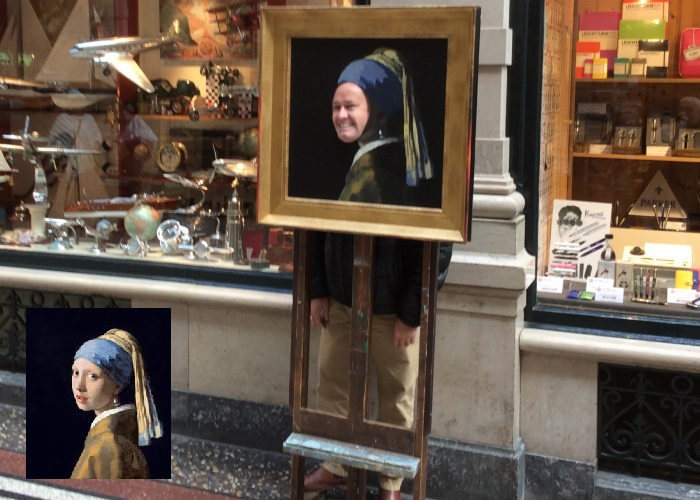 This is Vermeer's most popular painting of a 'Girl with a Pearl Earring' (1665-7). His paintings were destined to be hung in discreet bourgeois family dwellings where only a select few could see them (public collections and commercial art galleries did not exist in the 17th century). It was bought at an auction of his paintings in 1696, after his death in 1675, for a modest 36 guilders; now it is priceless and held at the Mauritshuis art museum in The Hague. I don't think Vermeer envisaged his works (real image inset) being subjected to tourist snapshots!! The pearl earrings look quite good on John though (LOL).
This is Vermeer's most popular painting of a 'Girl with a Pearl Earring' (1665-7). His paintings were destined to be hung in discreet bourgeois family dwellings where only a select few could see them (public collections and commercial art galleries did not exist in the 17th century). It was bought at an auction of his paintings in 1696, after his death in 1675, for a modest 36 guilders; now it is priceless and held at the Mauritshuis art museum in The Hague. I don't think Vermeer envisaged his works (real image inset) being subjected to tourist snapshots!! The pearl earrings look quite good on John though (LOL).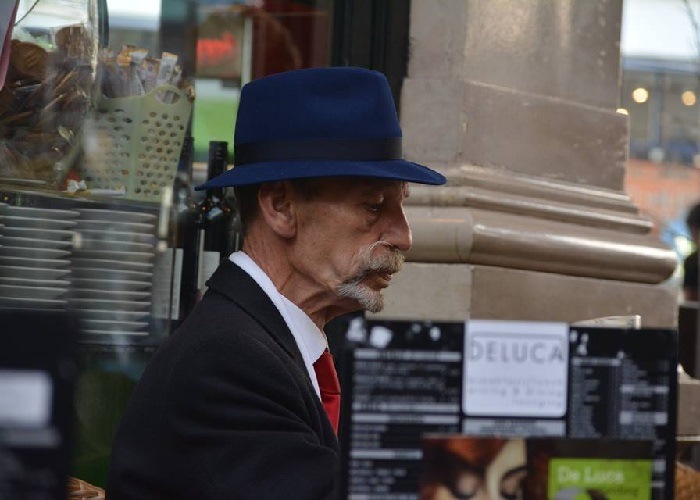 This gentleman was quite a character with a waxed and curled moustache; perhaps a bit rude of John to take a snapshot without him seeing but this was too good an opportunity to miss. He was very smartly dressed with white silk scarf, a shirt and red tie, long black coat and trilby, every inch the Maigret of The Hague.
This gentleman was quite a character with a waxed and curled moustache; perhaps a bit rude of John to take a snapshot without him seeing but this was too good an opportunity to miss. He was very smartly dressed with white silk scarf, a shirt and red tie, long black coat and trilby, every inch the Maigret of The Hague.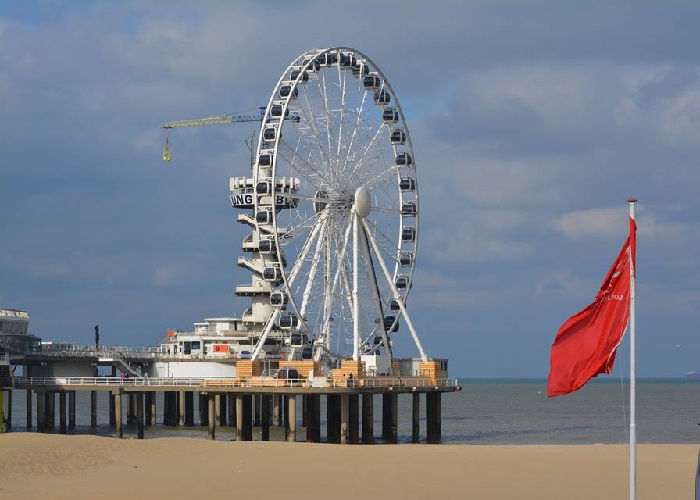 We left The Hague and drove to the seaside at nearbye Scheveningen; some local politicians are trying to re-brand Scheveningen as 'The Hague Beach', on account of the name being difficult to pronounce, but this has created a lot of problems with the local population who are very proud of the name Scheveningen. This town is a bit like Londoners going to Margate for the week-end as it is used by city dwellers to go windsurfing, sailing and fishing. It has a long sandy beach with a pier, promenade, amusements and a Ferris wheel - apart from the wheel and the pier which disappeared in the 80's, a bit like Margate really. I can't imagine Margate being rebranded London Beach though (LOL).
We left The Hague and drove to the seaside at nearbye Scheveningen; some local politicians are trying to re-brand Scheveningen as 'The Hague Beach', on account of the name being difficult to pronounce, but this has created a lot of problems with the local population who are very proud of the name Scheveningen. This town is a bit like Londoners going to Margate for the week-end as it is used by city dwellers to go windsurfing, sailing and fishing. It has a long sandy beach with a pier, promenade, amusements and a Ferris wheel - apart from the wheel and the pier which disappeared in the 80's, a bit like Margate really. I can't imagine Margate being rebranded London Beach though (LOL).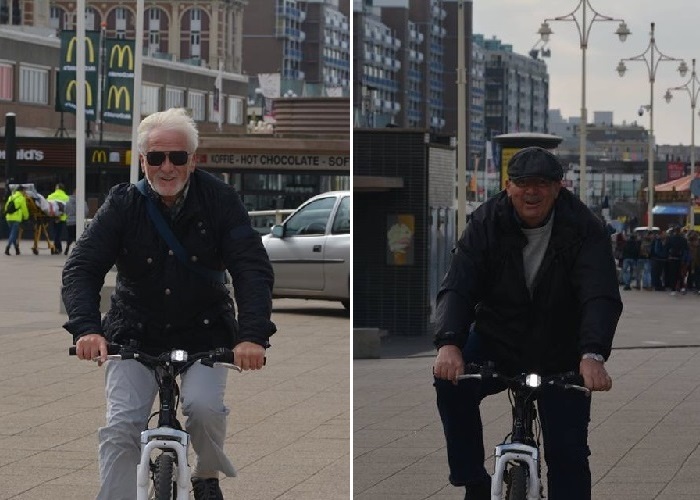 In keeping with tradition in Holland Tony cycled from the coach park and both Nick and myself had a turn round the promenade.
In keeping with tradition in Holland Tony cycled from the coach park and both Nick and myself had a turn round the promenade.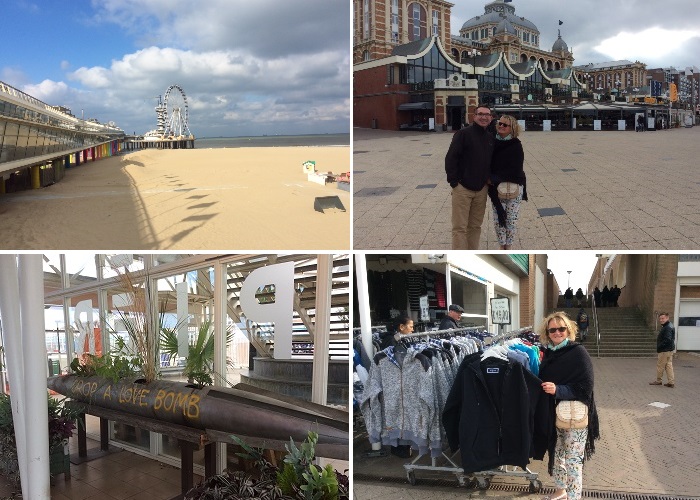 The popularity of this town is understandable with a lovely beach and a covered in land based pier; we had one lady on our coach who had been here before and came all this way, I think to buy some boots only to find the shop had closed down; as you can see there were still shops to be found!
The popularity of this town is understandable with a lovely beach and a covered in land based pier; we had one lady on our coach who had been here before and came all this way, I think to buy some boots only to find the shop had closed down; as you can see there were still shops to be found!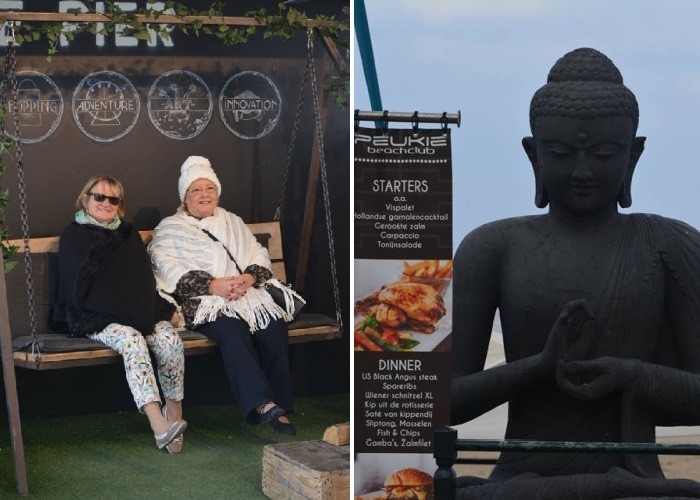 We had a nice relaxing wander along the pier, lunch in a nice restaurant and then it was time to move on to our last stop of the day at Delft. Given it was decent weather, we enjoyed our stay but I wouldn't come here again; being from a seaside town similar albeit not quite so 'nice' this was a bit too much like home.
We had a nice relaxing wander along the pier, lunch in a nice restaurant and then it was time to move on to our last stop of the day at Delft. Given it was decent weather, we enjoyed our stay but I wouldn't come here again; being from a seaside town similar albeit not quite so 'nice' this was a bit too much like home.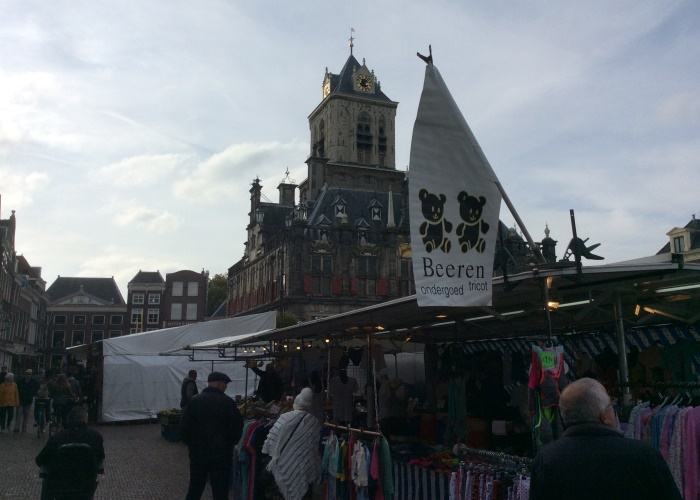 Delft is known for its historic town centre with market, canals and world famous Delft Blue pottery. Painter Johannes Vermeer was born and buried here and William of Orange (Willem van Oranje) moved here in 1572; at that time he was the leader of growing national Dutch resistance against Spanish occupation of the country (known as the Eighty Years War). In 1581, as the seat of the Prince of Orange, Delft became the defacto capital of the newly independent Netherlands.
Delft is known for its historic town centre with market, canals and world famous Delft Blue pottery. Painter Johannes Vermeer was born and buried here and William of Orange (Willem van Oranje) moved here in 1572; at that time he was the leader of growing national Dutch resistance against Spanish occupation of the country (known as the Eighty Years War). In 1581, as the seat of the Prince of Orange, Delft became the defacto capital of the newly independent Netherlands.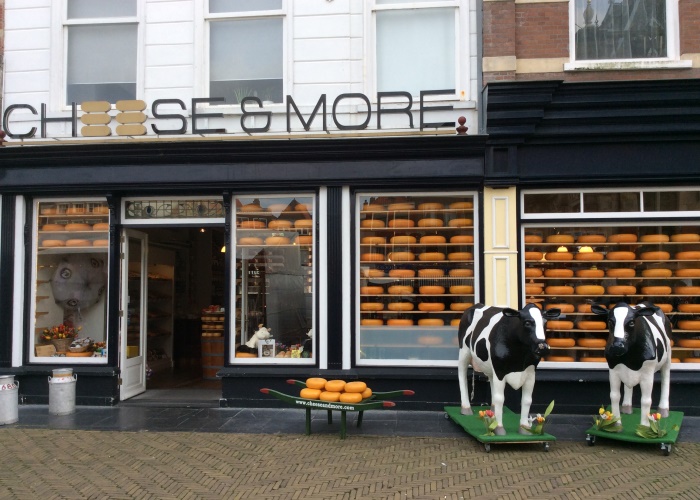 This shop is called 'Cheese and More'; my question is - where's the more? - every shelf is covered with cheese. Cheese (and flowers) are the largest Dutch exports with Gouda and Edam perhaps the best known; these are actually types of cheese, not brands as both Gouda and Edam are made by Uniekaas. Delft also has its own cheese called Delft Blue. The cheese in the shop appears to be Gouda (or possibly Alkmaar) which is only 20-30km from Delft.
This shop is called 'Cheese and More'; my question is - where's the more? - every shelf is covered with cheese. Cheese (and flowers) are the largest Dutch exports with Gouda and Edam perhaps the best known; these are actually types of cheese, not brands as both Gouda and Edam are made by Uniekaas. Delft also has its own cheese called Delft Blue. The cheese in the shop appears to be Gouda (or possibly Alkmaar) which is only 20-30km from Delft.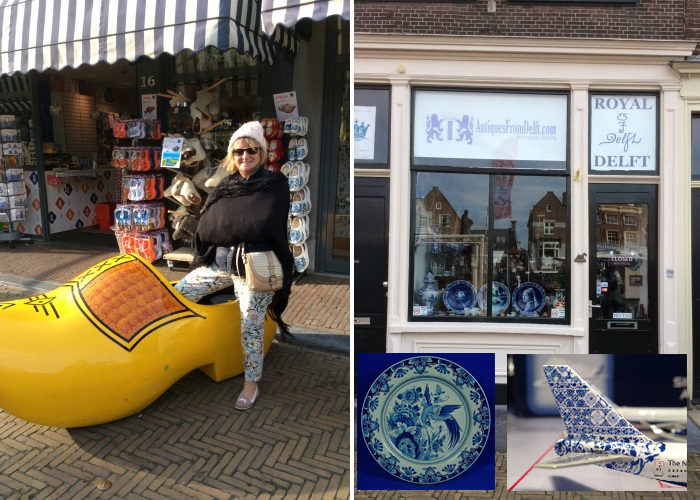 I don't think this shoe was made for walking! Big clogs outside shops seems to be a bit of a Dutch foible as we saw a similar thing in The Hague and Volendam. The shop on the right specialised in 'Delft Blue' pottery which is blue and white pottery made in and around Delft and is in the style of the tin-glazed pottery made in the Netherlands from the 16th century. A little known fact is that Delft Blue pottery formed the basis of one of BA' ethnic tailfins, the Delftblue Daybreak, that was applied to 17 aircraft in 1997.
I don't think this shoe was made for walking! Big clogs outside shops seems to be a bit of a Dutch foible as we saw a similar thing in The Hague and Volendam. The shop on the right specialised in 'Delft Blue' pottery which is blue and white pottery made in and around Delft and is in the style of the tin-glazed pottery made in the Netherlands from the 16th century. A little known fact is that Delft Blue pottery formed the basis of one of BA' ethnic tailfins, the Delftblue Daybreak, that was applied to 17 aircraft in 1997.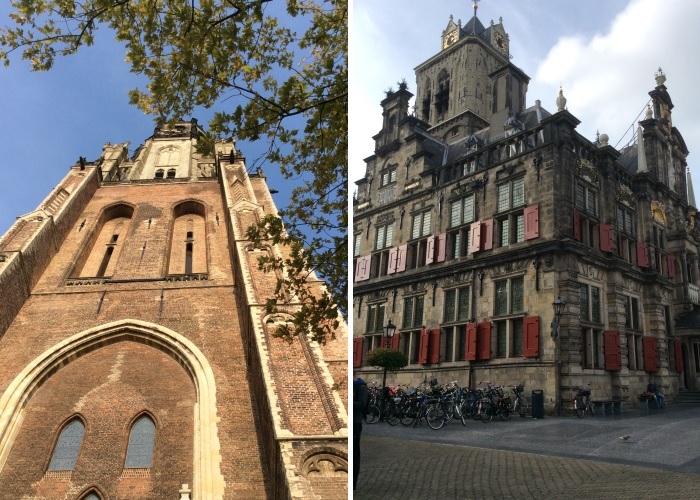 The 'Nieuwe Kerk' (New Church) in Delft dates back to 1381 and is closely connected to the House of Oranje-Nassau, the Dutch Royal Family. This church has the royal vault where the members of the royal family rest in peace including Prince William of Orange, the father of the nation who was shot in 1584 and was the first Royal to be buried here. The impressive mausoleum was built between 1614 and 1622 and restored in 1997; although you can visit the mausoleum the private family tomb is out of bounds. The latest family members buried here were Queen Juliana and her husband Prince Bernard who died within 6 months of each other in 2004. The Renaissance style town hall on the right is opposite the New Church and has been many things in its lifetime including a prison and was the place where Johannes Vermeer fulfilled his pre-marriage requirements (‘ondertrouw’) with his wife to be, Catharine Bolnes. It is still used for civic weddings and council meetings.
The 'Nieuwe Kerk' (New Church) in Delft dates back to 1381 and is closely connected to the House of Oranje-Nassau, the Dutch Royal Family. This church has the royal vault where the members of the royal family rest in peace including Prince William of Orange, the father of the nation who was shot in 1584 and was the first Royal to be buried here. The impressive mausoleum was built between 1614 and 1622 and restored in 1997; although you can visit the mausoleum the private family tomb is out of bounds. The latest family members buried here were Queen Juliana and her husband Prince Bernard who died within 6 months of each other in 2004. The Renaissance style town hall on the right is opposite the New Church and has been many things in its lifetime including a prison and was the place where Johannes Vermeer fulfilled his pre-marriage requirements (‘ondertrouw’) with his wife to be, Catharine Bolnes. It is still used for civic weddings and council meetings.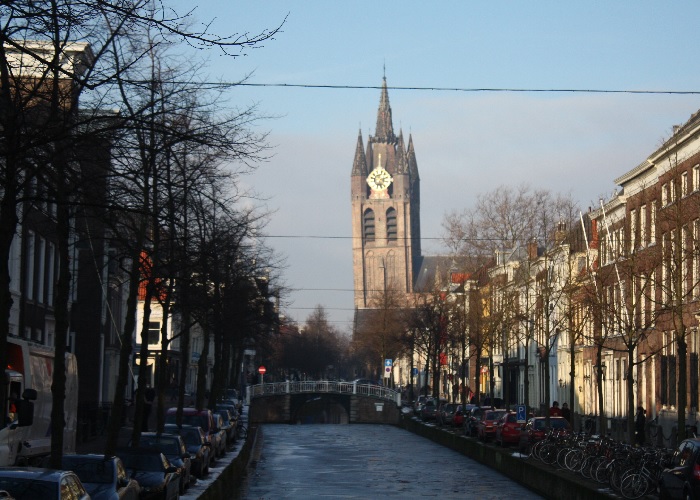 As well as the New Church there is also the 'Oude Kerk' (Old Church) which precedes the New Church by 150 years and is the location of Vermeer's grave. Like most artists of the time he had very little money and his family could not afford a tombstone so the exact location of his grave is unknown. Today his burial place has two grave markers: a rather austere one from 1975 to commemorate the 300th anniversary of his death, located at about the same place as the former family grave, and a new larger one near the western side entrance dating from 2007. The leaning tower of Oude Kerk is fondly called by the locals the 'Scheve Jan' (Leaning Jan).
As well as the New Church there is also the 'Oude Kerk' (Old Church) which precedes the New Church by 150 years and is the location of Vermeer's grave. Like most artists of the time he had very little money and his family could not afford a tombstone so the exact location of his grave is unknown. Today his burial place has two grave markers: a rather austere one from 1975 to commemorate the 300th anniversary of his death, located at about the same place as the former family grave, and a new larger one near the western side entrance dating from 2007. The leaning tower of Oude Kerk is fondly called by the locals the 'Scheve Jan' (Leaning Jan).